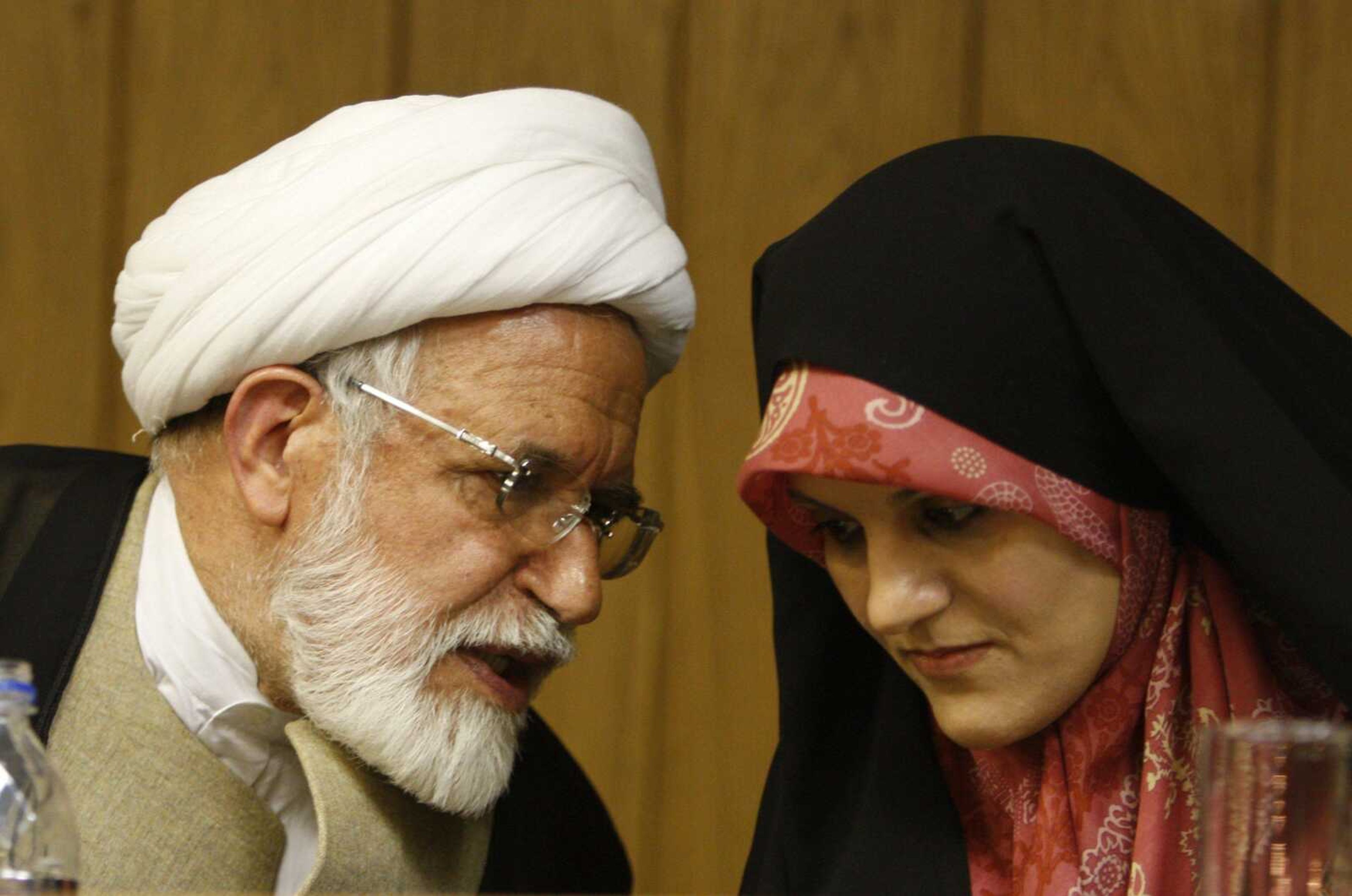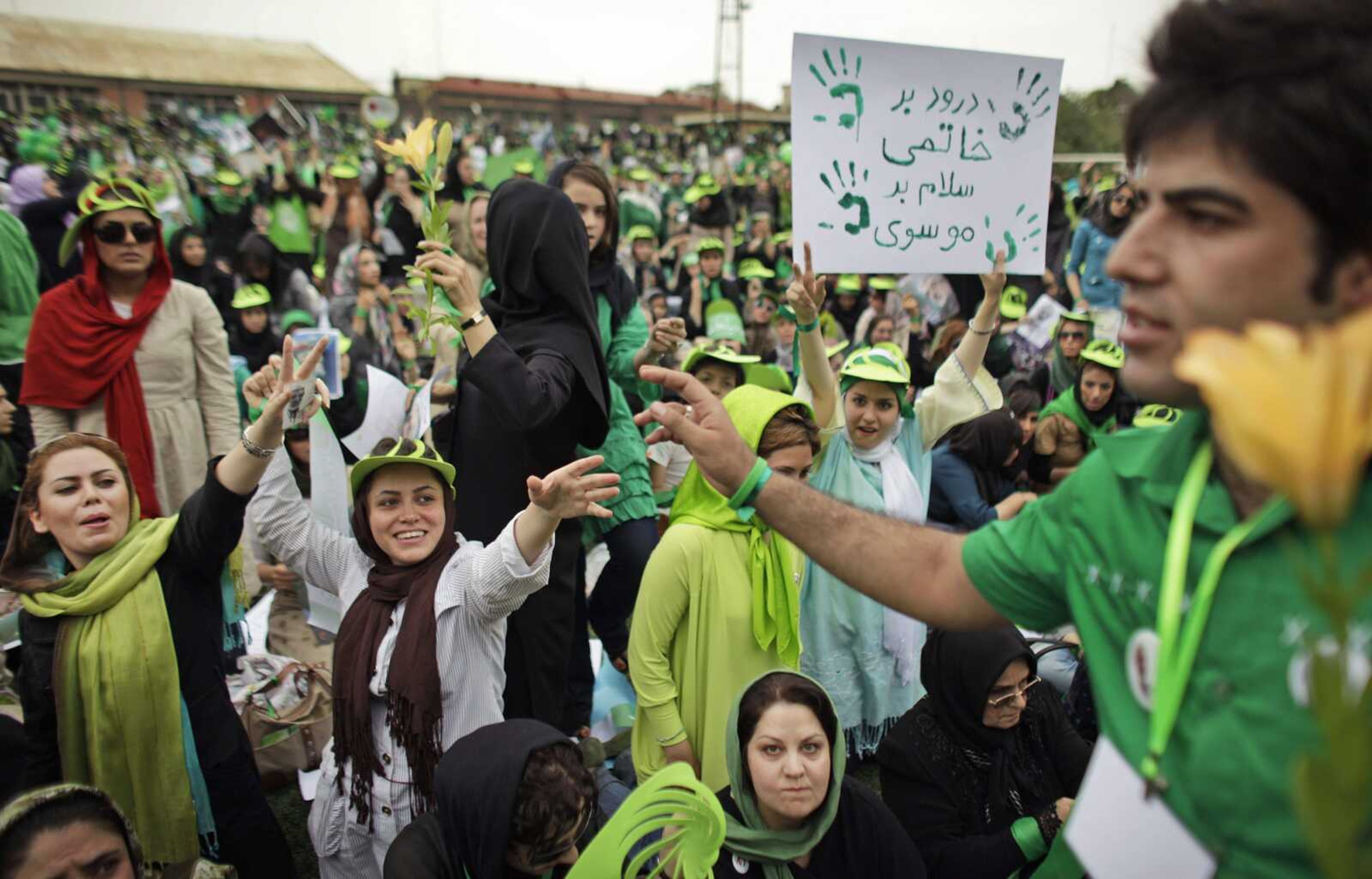Reformist's supporters are energized for Iran election
TEHRAN, Iran -- Persian hip-hop thumps from car speakers and young hipsters -- men with spiked hair and women in spike heels -- dance in the streets. It's another night and another campaign rally-turned-party for their unlikely hero: a self-styled reformist from the early years of the Islamic Revolution who is now seen as the best hope to defeat President Mahmoud Ahmadinejad...
TEHRAN, Iran -- Persian hip-hop thumps from car speakers and young hipsters -- men with spiked hair and women in spike heels -- dance in the streets.
It's another night and another campaign rally-turned-party for their unlikely hero: a self-styled reformist from the early years of the Islamic Revolution who is now seen as the best hope to defeat President Mahmoud Ahmadinejad.
But while Mir Hossein Mousavi generates the noise, passion and electricity in Tehran, Ahmadinejad has the backing of the Islamic establishment and support in the countryside, leaving Friday's vote too close to call.
Mousavi would appear to have the momentum, drawing large crowds and all-night street bashes. But all that noise, fervor and electricity doesn't necessarily add up to a juggernaut, with critical stakes at play, including possible talks with Washington after a nearly three-decade diplomatic estrangement.
The post-midnight raves in Tehran's leafy suburbs are uncorking passions that seem to have caught even Mousavi by surprise. On Monday, he stood at one end of a nearly 12-mile human chain of supporters along one of Tehran's main thoroughfares, linked by green ribbons and banners, the color of his campaign.

What's left in the final days before the vote is a flat-out political end game that's rewritten the rules of Iranian campaigns. This time, the attacks have been nastier, the crowds wilder and the media war more acute than any previous presidential race.
It's partly because of the moment. Iran faces many decisions, including whether to agree to international demands to suspend its uranium enrichment program, and how to respond to President Obama's call for dialogue.
There's excitement in the reformist camp, which lost the presidency at the end of President Mohammad Khatami's second term in 2005. Its supporters think Ahmadinejad is ripe to fall.
Iran's economy is sinking under the twin burdens of widespread mismanagement and double-digit inflation despite oil and gas reserves. There's a growing sense Iranians are tired of the international snubs and denunciations from Ahmadinejad's provocative statements, including questioning the extent of the Holocaust and calling for Israel's destruction.
"A month ago, I would have said Ahmadinejad was a sure bet," said political analyst Sharif Emam Jomeh. "There was apathy especially with the youth. But now, until 3 a.m., they are out in numbers and they care. ... Below the surface, something was boiling."

At stake is whether the next president will challenge or reinforce clerical influence on the state. The non-elected clergy around Supreme Leader Ayatollah Ali Khamenei hold most keys to power and dictate decisions over internal security, justice and foreign relations. There is little possibility to chip away at their constitutional clout. The presidency is the closest the voters can get to altering the direction of the country.
Mousavi's backers want to recapture the energy and possibilities of a decade ago, when then-President Mohammad Khatami opened the way for greater freedoms that included liberal media voices and a softer touch with outreach to the West.
The clerics struck back during Khatami's 1997-2005 term by muzzling many newspapers and jailing activists, but generally gave ground on social issues such as allowing more permissive music, films, freedom of expression and women's head scarves that show more hair than they cover.
Loyalists to Ahmadinejad laud him as a champion of the poor and forgotten, and rally behind slogans of patriotism and national pride. They applaud Ahmadinejad's declarations -- which are certainly endorsed by the ruling clerics -- that Iran will never abandon uranium enrichment and his rebuff of Western nations in favor of budding ties with U.S.-bashers Venezuela and Bolivia.
"Our supporters are many and we don't have to gather in the streets like this. I support Ahmadinejad because he is not stealing and is with the people. He cares about us," said taxi driver Hossein Ghorbani, 27, after heckling some Mousavi supporters.

But it's the party-style Mousavi rallies that have become the defining image of the four-way campaign -- which also includes a former parliament speaker and a commander of the powerful Revolutionary Guard.
Police watch, but have not intervened, as thousands of Mousavi supporters fill streets and parking lots decked out in green: T-shirts, head scarfs, bandanas, even battery-powered green blinking headbands.
"There is so much pressure on youth today and Iran has a bad image. We don't usually get to go out like this. It's like killing two birds with one stone. We have fun and it's politics," said 21-year-old Fatemeh Taherian as she sat on the median of a crowded street in northern Tehran's Sadatabad district before dawn on Tuesday.
Nearby, young women danced openly in the streets and hung out of car windows swaying to pop songs. But they were careful to keep on their head scarfs -- just barely -- to avoid any possible crackdown from hard-line authorities. One women, who wore a green-and-black polka dot headscarf, took it off for a moment but then quickly retied it around her hair.
It's not the first time that Tehran's streets have turned into playgrounds. Young people poured out after Khatami's second victory in 2001 and key wins of Iran's beloved national soccer team have brought massive traffic jams and celebration dances on car hoods.

But the growing Mousavi fests offer a key lesson in the potential power of Iran's youth.
About a third of Iran's eligible voters were born after the 1979 Islamic Revolution and grew up without direct memories of the early upheavals, such as the storming of the U.S. Embassy and the 444-day hostage standoff or the early years of the 1980-88 war with Iraq. Their views are often defined by the borderless world of the Web, which Mousavi tapped to build early momentum while Ahmadinejad relied heavily on state-controlled media.
Mousavi has peppered Ahmadinejad with biting criticism, including saying he was leading Iran toward "dictatorship." Ahmadinejad has countered with claims that Mousavi is part of a corrupt clique of past political leaders.
Mousavi -- who served as prime minister from 1981-89 -- was little more than a politician from another era for many young voters a few months ago. But his campaign has managed to galvanize the forces against Ahmadinejad behind him. Some Mousavi backers don green smocks with the saying "The third way" -- a reference to the third generation of the Islamic Revolution.
"I believe it is a new beginning and I want to take part in it," said 26-year-old Parastou Pazhoutan.
There's also a touch of rifting off the Obama campaign, Iranian style. Mousavi's slogan: The Hope Government. He also appears on a poster with a message in English: "A New Greeting for the World."
Ahmadinejad's campaign line: "We did. We can."
"I don't want to overestimate it, but people do think that now the world has changed," said analyst Emam Jomeh. "Obama has come to power and it's time for Iran to change."
The verdict on Friday could be decided outside Tehran, where Ahmadinejad is strongest. In the northeast city of Mashhad -- Iran's second-largest -- thousands of Ahmadinejad supporters have turned out for daily rallies.
There are signs, however, of important headway by Mousavi's campaign.
In the southern city of Shiraz, more than 5,000 Mousavi supporters joined in a mile-long human chain on Tuesday.
Part of Mousavi's appeal has been boosted by the popularity of his wife, former university dean Zahra Rahnavard, who has called for greater opportunities and rights for women.
In an interview with the British Broadcasting Corp., Rahnavard was asked about comparisons made between her and first lady Michelle Obama.
"She is not model for me," Rahnavard said. "She is Zahra Rahnavard in America, but I respect her."
Asked about possible relations with the United States, she replied: "We are going to have good relation with any country who respect Iran. And we are going to have relation with them except Israel."
Connect with the Southeast Missourian Newsroom:
For corrections to this story or other insights for the editor, click here. To submit a letter to the editor, click here. To learn about the Southeast Missourian’s AI Policy, click here.









